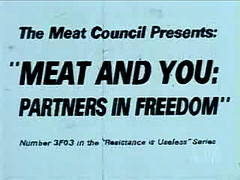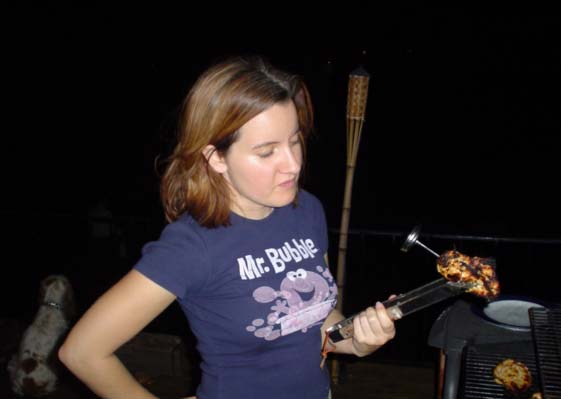
Not quite satisfied with my inability to get a quick answer to my meat thermometer quandary, I did a Google search on “Food Safety Question.” “Ask Karen” popped up as the first hit. She’s the FSIS virtual representative for USDA. I typed in my question, “Do I need to wash my digital meat thermometer or is this bad for the mechanism?” This is what Karen said:
Thermometers are devices that measure temperatures. Using a food thermometer is the only reliable way to ensure the safety of meat, poultry and egg products. To be safe, these foods must be cooked to an internal temperature high enought [sic] to destroy any harmful microorganisms that may be in the food.
* Are food thermometers best for large cuts of meat?
* Can oven-safe bimetallic coil thermometers be used in the oven?
* How accurate do thermometers need to be?
* How many people use a food thermometer?
* How to use a food thermometer?
* Can I use a people thermometer for meat and poultry?
* What are deep fry thermometers?
* What is a bimetallic coil thermometer?
* What is a liquid-filled thermometer?
* What is a pop up timer?
* What is a refrigerator thermometer?
* What is a T-Stick?
* What is a thermistor thermometer?
* What is a thermocouple thermometer?
* What is a thermometer fork?
* What is an instant-read thermometer?
* What is an oven cord thermometer?
* What is an oven thermometer?
* What is the proper way to clean a food thermometer?
* What percentage of Americans own food thermometers?
* What types of kitchen thermometers are available?
* Where can I buy a food thermometer?
* Why is it so important that people use a food thermometer when cooking meat, poultry, and eggs?
If I were anyone else, I would have given up with this huge list of questions. But being the inquisitive (stubborn) nerd that I am, I searched through and clicked on “What is the proper way to clean a food thermometer?” Karen says, “As with any cooking utensil, food thermometers should be washed with hot soapy water. Most thermometers should not be immersed in water. Wash carefully by hand.”
Karen’s advice sounds … sound. But it isn’t really practical if I’m cooking two things on the grill at once. Will the internal temperatures get hot enough to kill the microbes on the metal if I probe another piece of meat? I’m certainly no scientist, but I wonder what the real cross-contamination risks are. I also wondered if another source would give me a different answer.
Next I Googled, “Wash meat thermometer” (in quotes) and I got exactly one result– a document entitled “FY 2001 Annual Report of Accomplishments and Results: Oklahoma Cooperative Extension Service.” This report, comprised of many project overviews, provided one on “Quick & Easy Cooking Schools.” In this project pilot cooking schools were offered in two Oklahoma counties, one of which had a 159% higher rate of foodborne illness than the rest of the state and this was 219% higher than the rest of the U.S. Using a 70 page Quick & Easy Cooking School curriculum, thirty cooking schools were taught in 2000. As a result, the worst county (Washita) dropped from 159% above the state rate to 100% below the state rate for foodborne illnesses. Here are some other “anecdotal” results:
“In addition, there was an increase in the number who used a meat thermometer after attending the cooking school. Moreover, the following are samples of additional food safety comments from participants regarding what they learned: ‘Wash meat thermometer in-between insertions. Do not just rinse the grilling tray that held raw meat but wash it before putting cooked meat back on it. Do not thaw meat on the counter.’”
My friends at iFSN also found the following references for me:
From the Beef Information Centre “Thermometer Know-How” states, “Always use hot soapy water to wash the tongs, plate and thermometer stem used in checking partially cooked meats before using again.”
From the food safety network’s own page, Cooking Temperatures 06.jul.05, “Wash the thermometer stem in hot soapy water every time you use it.”
The explanation that finally cured my curiosity was this one from O. Peter Snyder Jr. His study, “FOODBORNE ILLNESS HAZARD CONTROL STRATEGIES FOR CHURCHES AND NON-REGULATED GROUP FEEDING SITUATIONS” in 1992 for the Hospitality Institute of Technology and Management (May 1998 edition) explains that while cooking large pieces of meat, “Do not roast meats, etc. on a spit or stick the meat with a fork, because it will unnecessarily contaminate the center of the food. Always wash the stem of a thermometer before putting it into cooked, ready-to-eat food.”
Now on to investigating how many people use a fork when they grill.
 Dr. Richard Raymond, the Agriculture Department’s undersecretary of food
Dr. Richard Raymond, the Agriculture Department’s undersecretary of food 
 Steve Gustafson, program manager for a California county’s Division of Environmental Health, shared some frank words wth the
Steve Gustafson, program manager for a California county’s Division of Environmental Health, shared some frank words wth the  First it was the
First it was the  … is give LOX a chance.
… is give LOX a chance.
